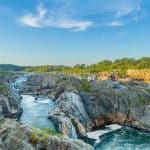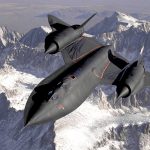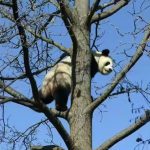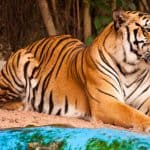Day 1
Check into our evening flight at Heathrow airport. Out of the two pieces of 23kg checked luggage we are each allowed Brian and I have less than 200 grams to spare between the both of us. Hope we don’t have to carry our bags around too much! We meet Tim from Toronto Zoo in the departure lounge and after a brief introduction hop on the flight to Nairobi.
Day 2
2 rubbish films later and not very much sleep we arrive in Nairobi where there’s a quick transfer to catch our flight to Antananarivo, Madagascar. Get a great view of Kilimanjaro on route and touch down in ‘Tana’ 4 hours later. It doesn’t take us too long to get through passport control where we are met by a frantic army of porters all trying to scramble for our bags. Great! There’s a taxi driver waiting to take us to our hotel which I don’t think will win any awards on trip advisor, but hopefully it’s only a day or two before we head out to our first sampling site!
Day 3
After breakfast we’re met by Tsilavina from Tana university who will be accompanying us on the trip. We run through a few project details then head off to the university. The campus is huge although much is without electricity which is quite common due to the frequent power cuts.
There are a few aquariums at the uni with native fish in including a stunning if not some what aggressive Paratilapia bleekeri and an amazing Coelacanth pickled in formaldehyde in a cabinet in one of the corridors. After running through our project details with Tsilavina’s boss, Dr. Rakotondraparany, who is head of the Zoology Department we head off to track down somewhere with an internet connection. Easier said than done. If it’s this difficult in Tana I have the feeling it’s not going to get any easier where we are going. In the afternoon we meet one of Tsilavina’s students Narina who will also come along with us.
Day 4
Up at 6am to get a taxi to the nearest national park Andasibe. Looks like our stay in Tana will be a bit longer than we anticipated. Organising permits, vehicles and collecting money are all taking longer so we head out of the capital for the day while we wait.
On the 3 hour journey back to Tana, I start to get an idea of the pollution and poverty facing Madagascar and wonder how far up the list of priorities conservation comes? Yet with such a diverse and unique group of native species it would be almost criminal for the rest of the world to stand by and let these animals become extinct. I get continually chucked around the taxi as the driver negotiates the many hairpin bends while overtaking lorry after lorry or swerving to avoid potholes or the occasional zebu. I’m assured this is one of the best roads in Madagascar.
Day 5
Breakfast at 7 is followed by another trip to the university to meet the boss of Tsilavina’s boss to discuss our project. Brian has a meeting after this with the British ambassador who kindly helped to arrange a grant to part fund the expedition. Tim and I go shopping to get provision for the journey ahead. As evening draws in there’s thick smog over Tana. I don’t think vehicles are emissions tested here and there is a faint smell of bonfires. The air is hot and sticky, I can’t wait to get out of Tana.
Day 6
Up at 6am for a quick breakfast then load up the cars to head out to the field. Tsilavina, Tim and Narina are in one car, Brian and I are in the other with a local driver. It takes us an hour to get out of the sprawl and into the country side….or what’s left of it! The 7 hour drive to our first stopover is like driving through a nuclear explosion. No trees, no plants, just bare orange red soil.
Slash and burn seems to be the national sport and the Malagasy are very good at it. I kept hoping that we’d turn a bend in the road and it would all be different but 7 hours later I’d given up. There was the occasional buzzard overhead and lots of Zebu, the local cattle which were grazing the last of the landscape. Every so often I’d see a lone figure standing in the distance in the middle of know where. I started trying to imagine what someone would be doing out there in the 38 degree heat. I could only think that he was looking for something else to burn.
We arrive in Ankarafantsika national park in the late afternoon where we pitch our tents for the evening. The last hour driving to the park the roads had gotten a lot worse. It took a good 10 minutes for my legs to start working when we finally got out the car but I quickly forgot about it after the first Sifaka bounced past overhead.
We managed to arrange a local guide to take us around the edge of the park for a night walk. We get a quick glimpse of a mouse lemur, lots of rats and a slug. Had a terrible nights sleep. Madagascar has many nocturnal animals, most of which spent the night hanging out round my tent.
Day 7
Up at 6am for a quick wash, breakfast and pack our tents away. We stop to have a look at one of the lakes just inside the park entrance. It’s the last known place where Paretroplus maculatus, an endemic species of fish are found in the wild. To my horror the lake is not much bigger than a few football pitches. Although it’s in the national park there are children fishing. We see at least 4 huge crocs in the middle of the lake. I imagine these are the only thing stopping the maculatus being fished into extinction.
On the drive out the park we pass what look like lots of dry lake and river beds. A few still have tiny puddles of water where people crowd round to do their daily washing or bathing. I wonder how many species of fish use to be in these rivers and how many are now extinct. It’s a 6 hour drive before lunch, more slash and burn countryside.
I never realised grazing cattle was so destructive. I should seriously consider turning vegi. Tsilavina goes to get part of his car suspension fixed while we eat. We are still on the main road but the cars are taking a real hammering.
It’s a further 6 hours until we reach the tiny town where we will be based for most of our time. The road here was more of a track than road and the super highway around Tana seemed a million miles away now.
Over dinner we meet the rest of the partners for this expedition, Guy, Fidel and Norbert. Almost immediately Guy hands us a blurry photograph of the fish we are looking for insolitus! The first pic is old, the next one is dated October 2013!! Our fish is still alive, I cant believe it!!! I’m brought back down with a thump by the next photograph of the place it was caught. A tiny puddle which now at the end of the dry season may well not be here anymore.
On hearing of our quest for the ugly fish of Madagascar Guy had asked Norbert, a local fisherman to go try to find the fish for us. Previous surveys in 2008 of the Sofia and Mangarahara rivers where the fish used to be found were to no avail. This year the Mangarahara was bone dry and Norbert had found the fish in a tiny tributary which was most likely the last place this fish could be found. We check into our hotel. No electricity or running water. Everything in Madagascar is relative and like the roads, our hotel in Tana suddenly seems palatial!
Day 8
I’m woken at 4.30am when every rooster in town start to cockadoodledoooo and then at 5.30am when the school next door starts to fill up for the day. After a quick wash under a cup of water from a stagnant bucket in my room I stagger out my room and into the bright 6am sunshine. I don’t think people here see many westerners and everyone stares as they walk past. The braver children give a nervous wave followed by “sali vahsa” which means hello foreigner although many kids just run and hide at the first sight of us (mainly Brian).
We have a long day of meetings with local officials. We stop at the Mayor’s office who isn’t in as it’s a Saturday but his deputy is tracked down and brought to us. Me, Brian, Tim, Tsilavina, Guy, Fidel and Norbert are taken to a tiny dark office and Tsilavna explains to the deputy why we are here and 15 minutes later we are granted permission to continue.
Next we meet the head of the regional university who also use to be responsible for overseeing the local parks. A man with the most immaculately cleaned and ironed outfit. He agrees to accompany us to all of our sample sites to help us get access. Next it’s the local police followed by the regional police office. Each time Tsilavina introduces us all and each time he has to explain our reason for being here. I have no idea what was being said as everything was in Malagasy but everyone seems happy and we go for lunch.
Brian gives everyone a powerpoint presentation after lunch on the status of Madagascar fishes in zoos and aquariums which Tsilavina in turn translates to the crew. We finally open up the maps, everyone gathers round and we begin to thrash out a detailed plan to survey the local tributaries then it’s off again to the police station to submit our itinerary and gain final security approval, or something. That evening we manage to find somewhere with beer although it’s not what I’d call cold, still its all relative.
Day 9
We leave early for the tiny village of Marovato. Both cars now have 5 people in each and are full to the brim with equipment. The road soon turns into a track which soon turns into little more that a bumpy winding path. The journey would be impossible during the rainy season on anything other than Zebu and cart or by foot which is what the locals use. Each time we approach a village (which is nothing more that a few mud huts clustered together) all the children run out excitedly to see the car only to run off in horror the minute they see the vahsa inside.
We are right amongst the burning now and everywhere smells of bonfire. The only trees spared destruction are the Mango trees and everyone we pass seems to be eating them.
We finally reach Maravato at 4pm. The only problem, it’s on the other side of the river. Fortunately for us the 150 meter wide river has only got a fraction of water in and its quite shallow, the only flowing water I have seen since passing the Sofia 3 days ago. We leave the cars and wade across to the village to track down the local chief to ask for permission to pitch our tents and talk about fishing. After a wait, we all cram into a hot, tiny, dark room with amongst other things Britney spears posters on the wall and plastic flowers draped in the corners. Tsilavina begins the routine of explaining our mission to the chief who listens intently.
I start to feel faint as the heat and lack of air get increasingly worse. I look at Brian who looks like I feel. I stare at the posters to try to take my mind off the situation while still trying to look interested in what’s going on around me. It doesn’t help!
Back across the river to pitch our tents on the dry part of the river bed then back to the village to get some food from 2 local ladies who agreed to cook for us. We all cram into a tiny hut along with 2 chickens and a duck begging for scraps under the table. No chance of a cold beer, not even a beer so we settle for warm flat coke, possibly the best part of the meal. It’s all relative! That night there’s a lightning storm in the distance, in the other direction the orange glow of bush fires. If the rainy season starts early we’re going to be stuck here.
Day 10
Back to the village for breakfast. Rice with a glass of hot rice water. Mmmmmm. Fortunately we’d brought a jar of coffee, orange juice and condensed milk. Condensed milk and rice actually tastes relatively good. I live in fear of the day there’s no coffee for breakfast. The Malagasy probably feel the same about rice. The only problem with the coffee was that boiling a pan of water for coffee meant stoking the fire which was in the same tiny baking hot hut we were sitting it. We were finally going to get to do some fishing today a few kilometres upstream of Maravato. It was either a 2 hour drive or a 4 hour trek so we all piled into the biggest 4WD and set off.
5 hours later and there was still no sign of the river. The car kept getting suck at every hill and we’d all have to jump out and push. It must have been at least 35 degrees. There was just a maze of paths weaving across the charred landscape and none seemed to lead to the river.
We finally stumbled across an old guy with a machete in the middle of nowhere and managed to persuade him to squeeze into the car and take us to the river.
There was a collection of huts where we finally reach the river and very quickly a crowd of bemused onlookers who were given the now almost ceremonial explanation of our quest. While Tsilavina spoke to the villagers about the types of fish they were catching I thought it might be useful to show a photograph of the fish we were looking for. Within seconds I was surrounded by 20 people all jostling for a look.
Some recognised the fish but most had never seen it. We settled down to do some water testing while the entire village (and a duck) looked on before getting the net out to start fishing.
People quickly ran down into the river to help and after the first couple of unsuccessful attempts Norbert jumped in and started barking instructions.
Having a local guy who fishes these rivers for local species paid dividend and we finally had fish. Tilapia, a non native invasive species introduced as a food source and one which often out competes the local populations. Not the start we’d hoped for. A couple of attempts later and we had a couple of gobies and 1 small native fish and lots more tilapia. This continued for a couple more hours but we got no more native fish so we decided to call it a day.
On the way back up to the car a lady came up to us with a bowl containing a dozen small brightly coloured fish. “Zoohno” or small fish as they are collectively known in Malagasy. But these were native and there were no records of this species in this location. Further still Tsilavina had never seen this colour morph anywhere and this could be a new species or subspecies.
The lady took Tim and I down to where she had caught them, 20 meters from where we were fishing! We took details and recordings of the habitat but it was getting late and we needed to get going now. I can only think the villagers didn’t think these fish were important due to their size. That night it rained.
Day 11
Rice for breakfast.
After Tsilavna’s discussions with the local fishermen it was decided we should leave Marovato and move on to the next tributary to look for our ugly fish. We set off back down the same track we came from but now it was wet and much slower going. We arrived at Pont Sofia at 5pm, a dirty little village on what I’d now started calling the main road.
It was too late to carry on to the site we wanted to fish. Tsilavina wanted to take water samples and camp the night before heading on to the next site. Guy, Tim, Brian and I opted for the 2 hour drive back to the main town and the prospect of a hotel room for the night and promise of a cold beer. The thunder and lightening that night was more spectacular than the last. Rainy season was moving in. I hope the roads will hold out a bit longer and I’m glad not to be camping tonight.
Day 12
Bread and omelette for breakfast with a small side portion of rice!
The road back to Pont Sofia got wetter the closer we got. It looks like the guys had got caught in the downpour last night. To make things worse they had pitched their tents in what appeared to be the local, rather pungent cattle corral and were now surrounded by zebu. We quickly packed up and set off down a tiny track towards our next fishing site. If the roads up until this point were very bad this track was very, very bad.
What made things worse was the huge rocks and boulders littering the track and it was only 2 hours into the drive when our car started to make a strange knocking noise and burning smell. We parked under a mango tree, the only shade around and the driver started taking the front wheels off and dismantling something inside.
The site was still another 40 km upstream along the track, we weren’t even half way yet. There were 3 people fishing in the river close to where we were parked using what looked like an old mosquito net. Guy went over to ask them what they were catching but they said there was only tilapia here. An hour later the decision was make to abort the site and head back. The clutch was starting to go and if we went much further and it did we would really be without a paddle. 4 hour drive back, 8 hours driving in total for the day and we were back where we started. The enormity of the task was really starting to hit home. This was about looking for 1 fish in a relatively small area. There were many more critically endangered fish throughout Madagascar, under just as much threat of extinction and in equally remote locations.
That evening we revised our plan. We had intended to leave the site where the fish had last been seen until the end part of the expedition. That way if the habitat and fish population was in very poor shape as we suspected it would, we would be in a position to remove the fish and immediately take them to Guy’s aquaculture facility some 3 days drive away. Now that the cars were falling apart and the rain was moving in the decision was made to concentrate on this one site.
Day 13
This really is our last chance of finding the fish and maybe the last chance for this species! No pressure. I couldn’t help but think the situation would be different if the species wasn’t so ugly but even the Lemurs get eaten here. Nothing is spared! It’s all about survival and its every species for its self. The site was about 4 hours away and the ‘road’ is supposed to follow the river quite closely on route. This river is the last river where insolitus can be found and probably the only one that still has water in it so late in the dry season. Since the deforestation began, the sand and soil is being washing into the rivers and chocking them. Now the water that doesn’t evaporate in the burning sun is buried under heaps of sand and soil or too hot to support fish anymore. As we drive out of town we cross the Mangarahara River, which the fish was originally named after. The huge river was now completely dry apart from the holes that were being dug in the sandy river bed to collect drinking water or to wash cloths in. No fish here any more.
As we wind through mountains I keep looking out for glimpses of our river. Three hours into the journey and now I just want to see water, any water. We pass what look like dozens of small rivers and streams all of which are completely choked and dry. I only hope these aren’t the only sources of water for the main river we are looking for. We turn a corner and as if by magic the landscape changes. The scorched orange/red landscape gives way to vibrant green rice fields. There must be water here. But its not in the river, it’s in the rice fields! Momentary joy turns quickly back to fear as I realize that what little water might be here is going to be in great demand. We arrive in the village and are quickly greeted by a local fisherman who presents us with a small dried out fish. Its insolitus, and hopefully not the last one!
Word had got to the village of the crazy vasah looking for the ugly fish and they had caught us this one in anticipation of our arrival. The fisherman assures us he can find us more and Tsilavina explains not to bring us any more until he can show us where he got this one from. But first we need to meet the Mayor, local police and park official.
It was decided that Norbert and Fidel would drive out on motorbikes to look at the even more remote sites where the villager said there might still be water. They would fish for insolitus and report back to us the next day on what they found. The rest of us would follow the local fisherman to the site closest to the village where he said the fish might be found. We follow the last remnants of the river downstream which doesn’t flow anymore and is broken up into a series of pools for over an hour.
We pass people washing their cloths, washing themselves, watering and washing their animals, pumping water out for rice field and collecting drinking water. We finally get to the spot. It doesn’t look like much but the fishermen waste no time jumping in and begin trying to net stuff out for us.
We’ve got one! Alive!! I can’t believe it!! I hardly recognise it. The fish at the zoo are so old now they hardly look like the small juvenile Brian now has in his hands.
The last 12 days getting here evaporate in the afternoon sun and we all stand there with massive grins. What a relief. The fishermen pull out a couple of other native fish and we pack up and head for home, a catholic convent that agreed to house us for a couple of days if we behave ourselves. On the walk back I start thinking of what we need to do next. This is just the start of the next phase. But at least the fish is still here and alive.
At the current rate, this last remaining part of the river will be just as dry as the others we’ve seen, complete with sun, sand and no fish. We can’t fly the fish directly back to the zoo during the Northern hemisphere winter. The risk of them getting too cold is too great a risk. We can’t leave them here, what if we come back and they are all gone. The only option is to get them back to Guy’s aquaculture farm. And that’s not going to be easy.
Day 14
Rice for breakfast. Norbert and Fidel still aren’t back from the other fishing sites and we decide to fish some of the other pools downstream from where we found the fish yesterday. We fish each site for an hour, record species and numbers and take water quality readings.
We find 5 other native species in total, 3 of which are only found here and are going to be as extinct as insolitus if something isn’t done very soon. It looks like London Zoo’s Madagascar fishes conservation breeding program just tripled in size. I think we’re going to need a bigger aquarium!
Worryingly our fishermen find a plant used to poison fish in one of the pools. We only find small tilapia in that pond, no native species. The last site we fish throws up the biggest surprise of all. Brian is sorting through the catch, calling out the species and lengths. There’s a pause, hang on this is different. deramii? I have no idea. Tsilavina’s eyes light up and he runs excitedly over to the keep net. deramii!
Its just a small light brown fish about 5cm in length with long fins but this was thought to be extinct! This may be the last one ever! Its like stumbling across the last living Dodo or Woolly Mammoth!
We get back to the village and Fidel is back with good news. He’s found a group of insolitus in a pool further down the river. It’s a long walk from the nearest point we can drive to so fishing or collecting is out of the question but we will need to do water samples and record the site details at some point. Missed lunch so there is extra rice for dinner.
Day 15
Rice for breakfast, the weather is still holding out.
Tsilavina wants to follow the river further upstream in search of more deramii. Brian wants to follow the river upstream into the special reserve, a protected area with no access to anyone but park rangers. If the fish are found in the river here they would be protected in their native habitat and there would be a lot less pressure to breed them ex-situ. It’s a Saturday and the park ranger takes a lot of persuading to show us the park, let alone enter it! He reluctantly agrees and it’s a two hour drive South to the nearest tiny village. Its late morning by the time we arrive and its boiling hot! It’s a further hour’s walk to the reserve boundary and our bags are full of water testing equipment.
As we get nearer to the reserve the habitat totally changes. This is the first bit of primary forest I’ve seen since we arrived in Madagascar and what a sight!
Glad I’ve got my sun glasses on. After seeing the continuous, total wholesale destruction of every natural thing in the landscape and to then see this, hear lemurs barking in the distance and see birds fly around us is a bit overwhelming. This is what everywhere else use to look like before it was set on fire. As I look back from where we just walked from I fear it’s like looking into the future for the reserve. Next to the reserve there are areas cleared for cattle grazing, next to this small shrubs that have grow back after the grazing is finished. Next to this there are areas where the shrubs have been slashed and burned so grass can grow throw for grazing again. In the distance you can see hills that have been burnt too many times and the grass has stopped growing back and the soil is so poor it has started to erode and collapse. Then finally only 5 km away in the distance the hills are just orange/red dust with nothing growing on them. Just dust and no life.
We make our way down to the river at the edge of the reserve and stop for a break. We’re not allowed to fish but the water is really clear, no one can see any fish here. There are loads of invertebrate bugs in the water, a sign there aren’t any fish here as these would have been eaten by now. There’s a kingfisher close by and he can’t find fish either, just giant tadpoles. Either the water gets too cold or the fish can’t swim this far upstream. We head into the park and up to a water fall which is about 50m high, just like out of the tour brochure!
We don’t find any pools likely to hold fish but record water parameters and head back to the village. We show the villagers our fish pictures but they only recognise zoohno which are of least concern here at least. Rice for dinner, but there is cold beer before we head back to our convent!
Day 16
Rice for breakfast, I’m starting to quite like it. We’re going to try and catch our fish today and move them to Guy’s pond. Originally it was just insolitus but now we’ve got other critically endangered refugees fishes to bring along if we can catch them. The plan is that Brian will travel with Guy and the fish up to the ponds, a day and a half continues driving (that’s 36 hours non stop) before releasing them, then fly back to Tana. Tim, Tsilavina and I will continue sampling en-route back to tana with all the heavy equipment. That’s the plan anyway. We decide to leave the fishing until the end of the day. We don’t want to bag up the fish and walk them back to the convent in the sun, its too hot, they wouldn’t make it. It gets dark at 6, should take an hour to walk back to the convent from the site, an hour to bag up the fish and we probably need 2 hours to fish and an hour to get there. We set off on what is possibly the hottest day so far in the mid day sun. It’s going to be a long day!
As we leave the village there is 18 of us in total but as we get to the first site there’s now nearly 30 people! We split into 2 groups, set up our nets and begin fishing. The target is 20 of each species and we have to keep continually running between the two sites with a running total of what we’ve caught so far. Its organised chaos.
There’s kids jumping and swimming in the water, other people fishing for their dinner and at one point 3 zebu jump in and start swimming towards our nets.
Slowly we start to creep towards our total but it’s getting late and we need to stop soon. Just a bit longer!!! We haven’t got everything we wanted but time’s up. We have 20 insolitus which is what we originally came for. We bag the fish up as quickly as possible but it’s starting to get dark as we leave the site.
Glad I brought my torch. Back at the convent there’s time for a quick shower (couple of cups of cold water) before water changing each of the fish bags. It takes almost 2 hours to re-bag the fish and pack them ready for the journey tomorrow. Quick bowl of rice before bed.
Day 17
Brian is up at 4.30am to leave with the precious fish for the aquaculture ponds. The idea is to get through the worst part of the road while it’s still cool outside so the fish don’t over heat. Hopefully they will hit the better road by mid day when the car is going faster and there is more of a breeze to cool things down. The driver and Guy decide to take the driving in turns and continue non stop to the ponds. 36 hours solid driving! I don’t get out of bed to say goodbye. Rice for breakfast at 7am then Tim, Tsilavina and I head back up stream to do some more sampling.
No luck so we head back to the convent early and decide to go back to main town the same day. Its really hot on the drive back, must be 40 degrees. The road is so bumpy I manage to rip both grab handles off Tsil’s car. We get back to town but our normal rooms are booked out, the only thing left is a twin room with no windows, electricity, loo or water. There is no other choice but the beer is cold, bliss!
Day 18
Worst night sleep ever. No air. It was so hot I found myself pressed against the concrete wall at one point to try and cool down. Tim slept even worse, apparently I snore. Woken by the cockadoodledoos at 4.30. I run over and open the door to get some air but it’s not much fresher. It’s a 3 hour drive back to the site where Fidel and Norbert had found the other group of insolitus 3 days ago. We need to go there to record the site and take water samples. At the point where the car can go no further we jump out and set off by foot to find the river. It’s just gone mid day, it must be nearly 40 degrees and there’s no breeze or shade.
My backpacks weighed down with water testing gear and 3 litres of drinking water. It’s an hour and a half before we get to the river and we’re all exhausted when we get there. No chance of a quick swim to cool down as there could be crocs! The pool looks promising. The waters not flowing but the pool is deep enough not to over heat during the summer heat and there are a few mango trees along the bank.
We document the site for an hour before heading back to the car. The trek back is unbearably hot. I’m almost out of drinking water and it feels like my brain is baking inside my skull. As we get closer to the car I can feel heatstroke setting in as I start to get cold shivers down my body. We can’t stop as there’s no shade and we are nearly at the car.
On the drive back the rainy season finally catches up with us, and with vengeance. The wind picks up and starts whipping up a dust storm. A few drops of rain soon turn into a deluge and the dusty track we are driving down quickly turns into a muddy river. The truck struggles for grip and barely makes it up some of the slopes. Downhill is worse still and we slide around uncontrollably. As we slowly limp back into town it appears the storm hit hear even worse. Many of the huts have there roofs ripped off and there’s debris scattered over the road. The electricity is out for the rest of the night. The decision is made to start heading back towards Tana the next day. The smaller roads are too dangerous now and there is a real risk of getting suck.
Day 19
It’s a seven and a half hour drive to Port Berge. The roads and landscape now seem unremarkable but the sight of a developed town with shops, cars and electricity is now out of the ordinary. We find a place to stay and for the first time in 2 weeks there is running water and a shower…of sorts! That night there is another heavy downpour and I’m continuously woken by the sound of falling mangos crashing on the tin roof above me. Probably mango for breakfast tomorrow. Lucky we made it back to the tarmac road when we did as I’m sure the journey we made today would have taken twice as long, if we could make it at all.
Day 20
It’s a short distance from Port Berge to where the Sofia River meets the West coast of Madagascar and the Mozambique Channel. The plan today is to reach a small village on the estuary and find some fishermen to talk to about the species they are catching. Easier said than done! We set off down a small track in the general direction of the river. The rain the night before makes the going tough but at least the terrain is flat. The track branches into two every 100 meters and it’s soon a lucky dip as to which track to take and there are a couple of rickety looking bridges to cross.
I guess there’s not much need for road signs and car bridges around these parts. After 3 hours the track runs out and we park the car and head out on foot. It takes a further hour before we eventually find the village which is a cluster of 20 or so mud huts. Tsilavina finds a group of guys who look like fishermen and begins flicking through the fish photos with them. Tim and I head down to the estuary, no chance of a quick swim though, there’s crocs around. No insolitus here.
Some of the older villagers recognize the fish pictures but haven’t seen it for ages, the younger guys have never seen it and probably never will. In fact the only native species here are the occasional marine fish heading up the estuary. The walk back to the truck is a bit of a slog and we finally track it down with the GPS.
This point marks the end of our search for insolitus. Having started at the very top of the tributaries and headwaters of the mighty Sofia River in search of our ugly little fish we were now at the point where it reaches the sea. A fish, in fact many native fish that were once abundant throughout the hundreds of miles of rivers and waterways that make up the Sofia drainage were now clinging onto a fragile existence in tiny isolated pools in the head waters. At any rate, they won’t be around for much longer if something isn’t done very soon. We head back to Port Berge and that night we find a small hotel that has chips on the menu, with rice of course!
Day 21
Before heading back towards Tana we stop at a small stream along the road side. Tim had sampled the same area 2 years before and was keen to see if the water and fish had changed much since.
It doesn’t look like much, just a muddy trickle of water but after a few attempts we find a couple of native Pachypanchax and the now obligatory tilapia. We drive for 5 hours before pulling into a small town to stop overnight. Tana is still another 3 or 4 hours away and we are all pretty exhausted.
Day 22
There’s a definite sense of relief as we creep back into Tana. Made it! We get news back from Brian that the fish arrived safely and are now happily swimming around their new temporary home. Tim and I check into an amazing little hotel pack to the brim with historical Malagasy artefacts. My room is nice, has an ensuite with flush toilet, running water and the bed is the best I’ve slept in since leaving home plus there’s WIFI. For the first time in 22 days I check my emails. I secretly keep hoping for a power cut so I don’t have to read them all!
Day 23
Continental buffet for breakfast, not a grain of rice in sight. Tim and I meet a German vet student over breakfast and have a good chat about fish conservation, monkey pooh and parasites. Almost feels like I’m back home! That afternoon the three of use have a wander around the markets while continually being pick pocketed by gangs of children. Fortunately I had left my money, phone, camera and passport at the hotel so had nothing worth stealing. It soon turned into a bit of a game, well for me at least as I’m sure the children would have rather been at school or off playing football or something. That evening Brian arrived back.
Day 24
After breakfast we meet Tsilavina and head over to the university for a debrief. Brian spends some time running through the budgets with Tsil while Tim and I head down to the basement where there are some more fish tanks. After lunch there’s a bit of time to grab some presents for back home before heading back to the hotel.
Day 25
Brian has a breakfast meeting with the British ambassador Tim Smart to discuss our findings followed by a meeting with the head of the national parks authority. I hang out around the hotel pool and start wading through my emails. That evening I repack the bags ready for the flight back tomorrow. However much I take out the bags they never seem to get smaller or lighter. I think we need new bags!
Day 26
That morning Brian, Tim, Tsil and I have a discussion about the future, conservation and fish over a long breakfast. There’s a lot of work that still needs to be done. This is just the start. Hopefully now the rainy season has started and the last remaining fish in the river have earned themselves another year of existence. But what about next year? And what about the fish in the aquaculture ponds? Will they still be there next year? Will they breed and can we get some of them back to London zoo to start a breeding program? We sampled just 1 of the 30 or so river systems in Madagascar, all of which I’m sure have their own unique set of endemic fish species, threats and challenges.
Later that afternoon as I’m sitting in a quiet smoke filled plane cabin on the tarmac of Ivato airport waiting for the pilot to work out how to fix the electrical fault I cant help but think of my own survival.
To be continued … Hopefully….









